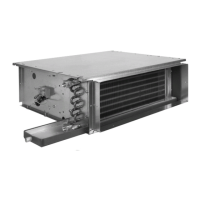Startup
UNT-SVX07J-EN 111
Dehumidification
Dehumidification is possible when mechanical cooling is
available, the heating capacity is located in the reheat
position, and the space relative humidity setpoint is
valid.The controller starts dehumidifying the space when
the space humidity exceeds the humidity setpoint.
The controller continues to dehumidify until the sensed
humidity falls below the setpoint minus the relative
humidity offset.The controller uses the cooling and reheat
capacities simultaneously to dehumidify the space. While
dehumidifying, the discharge air temperature is controlled
to maintain the space temperature at the current setpoint.
A typical scenario involves high humidity and high
temperature load of the space.The controller sets the
cooling capacity to 100 percent and uses the reheat
capacity to warm the discharge air to maintain space
temperature control. Dehumidification may be disabled
via Tracer® or configuration.
Note: If the unit is in the unoccupied mode, the
dehumidification routine will not operate.
Data Sharing
Because this controller utilizes LONWORKS
®
technology, the
controller can send or receive data (setpoint, heat/cool
mode, fan request, space temperature, etc.) to and from
other controllers on the communication link, with or
without the existence of a building automation system.
This applies to applications where multiple unit
controllers share a single space temperature sensor (for
rooms with multiple units but only one zone sensor) for
both standalone (with communication wiring between
units) and building automation system applications. For
this application you will need to use the Rover service tool.
For more information on setup, refer to:
EMTX-SVX01G-EN Rover Service Tool Installation,
Operation, and Programming manual.
Binary Inputs
Tracer® ZN520 controller has four available binary inputs.
Normally, these inputs are factory-configured for the
following functions:
• Binary input 1: Low temperature detection (freezestat)
• Binary input 2: Condensate overflow
• Binary input 3: Occupancy/ Generic
• Binary input 4: Fan status
Note: The generic binary input can be used with a
Tracer® Summit
™
building automation system
only.
Each binary input default configuration (including
normally open/closed) is set at the factory. See the table
below. However, you can configure each of the four binary
inputs as normally open or normally closed. The controller
will be set properly for each factory-supplied binary input
end-device. When no device is connected to the input,
configure the controller’s input as not used.
Table 53. Relationship between outdoor temperature sensors and damper position
Outdoor
Air Temp.
Modulating Outdoor Air Damper
Occupied or Occupied Bypass Occupied Standby Unoccupied
None or invalid Open to occupied minimum position Open to occupied standby minimum position Closed
Failed Open to occupied minimum position Open to occupied standby minimum position Closed
Present and
economizing feasible
Economizing minimum position to 100
percent
Economizing between occupied standby
minimum position to 100 percent
Open and economizing when
unit is operating, closed
Present & economizing
not feasible
Open to occupied minimum position Open to occupied standby minimum position Closed
Table 54. Binary input configurations
Binary
Input Description
Configuratio
n
Controller Operation
Contact
Closed
Contact
Open
BI 1
Low
temperature
detection
(a)
(a) During low temperature, condensate overflow, and fan status diagnos-
tics, the controller disables all normal unit operation of the fan, valves,
and damper.
Normally closed Normal Diagnostic
(b)
(b) Ta b le 5 5 shows the controller’s response to low temperature detection,
condensate overflow, and fan status diagnostics.
BI 2
Condensate
overflow
(a)
Normally closed Normal Diagnostic
(b)
BI 3 Occupancy Normally open Unoccupied Occupied
BI 3
Generic binary
input
Normally open Normal
(c)
(c) The generic binary input does not affect unit operation. A building
automation system reads this input as a generic binary input.
Normal
(c)
BI 4 Fan status
(a)
Normally open Normal Diagnostic
(d)
(d) If the fan mode input is in the off position or the controller is in the
unoccupied mode with the fan off, the fan status input will be open. A
diagnostic will not be generated when the controller commands the fan
off. A diagnostic will only be generated if the fan status input does not
close after one minute from energizing a fan output or any time the input
is open for one minute. The controller waits up to one minute after en-
ergizing a fan output to allow the differential pressure to build up across
the fan.
Note: The occupancy binary input is for standalone unit controllers as an
occupied/unoccupied input. However, when the controller receives a
communicated occupied/unoccupied request, the communicated
request has priority over the hard-wired input.

